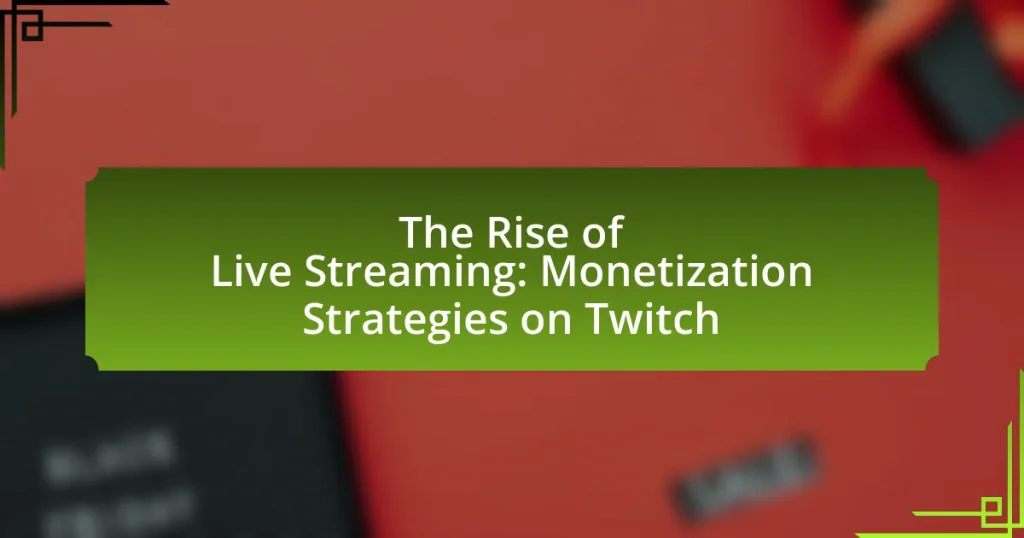Algorithm changes in social media are modifications to the systems that dictate how content is prioritized and displayed to users, significantly impacting user engagement, content visibility, and revenue streams for platforms and businesses. These changes are driven by the need to enhance user experience and adapt to user behavior, often prioritizing engagement metrics such as likes and shares. The article explores how these algorithm adjustments affect content visibility, the factors influencing content ranking, and the implications for advertising revenue and organic reach. Additionally, it discusses strategies businesses can employ to adapt to these changes, maintain audience engagement, and optimize their content for evolving algorithms. Understanding these dynamics is crucial for businesses to safeguard their revenue and effectively navigate the shifting landscape of social media.

What are Algorithm Changes in Social Media?
Algorithm changes in social media refer to modifications made to the underlying systems that determine how content is prioritized and displayed to users. These changes can affect user engagement, content visibility, and overall platform dynamics, often aimed at improving user experience or addressing issues like misinformation. For instance, Facebook’s algorithm updates have historically shifted focus from public posts to prioritizing content from friends and family, impacting how businesses reach their audiences. Such changes can significantly influence revenue streams for social media platforms, as they alter the effectiveness of advertising strategies and organic reach for brands.
How do algorithm changes affect content visibility?
Algorithm changes significantly affect content visibility by altering how content is ranked and displayed to users. For instance, when a social media platform updates its algorithm to prioritize engagement metrics, content that generates more likes, shares, or comments may receive higher visibility in users’ feeds. This shift can lead to a decrease in visibility for content that does not meet these new criteria, impacting the reach of posts and potentially reducing engagement rates. Historical data shows that Facebook’s algorithm changes in 2018 led to a 50% decrease in organic reach for many pages, illustrating the direct correlation between algorithm adjustments and content visibility.
What factors determine content ranking in social media algorithms?
Content ranking in social media algorithms is primarily determined by user engagement metrics, relevance of content, and recency of posts. User engagement metrics include likes, shares, comments, and time spent on posts, which signal to the algorithm that content is valuable and engaging. Relevance is assessed through user preferences, past interactions, and the use of keywords or hashtags that align with user interests. Recency ensures that newer content is prioritized, as social media platforms aim to provide the most current information to users. These factors collectively influence how content is displayed in users’ feeds, impacting visibility and, consequently, revenue streams for creators and platforms.
How do user engagement metrics influence algorithm changes?
User engagement metrics significantly influence algorithm changes by guiding platforms to prioritize content that retains user attention and interaction. High engagement rates, such as likes, shares, and comments, signal to algorithms which types of content resonate with users, prompting adjustments to content visibility and distribution. For instance, Facebook’s algorithm updates have historically favored posts that generate more comments and reactions, as evidenced by their 2018 announcement focusing on meaningful interactions to enhance user experience. This shift directly impacts social media revenue streams, as advertisers seek platforms that effectively engage users, leading to increased ad spend on platforms that adapt their algorithms to promote engaging content.
Why do social media platforms implement algorithm changes?
Social media platforms implement algorithm changes primarily to enhance user engagement and improve content relevance. These changes are driven by the need to adapt to user behavior, preferences, and feedback, ensuring that users receive content that aligns with their interests. For instance, Facebook’s algorithm updates have historically aimed to prioritize meaningful interactions, which has been shown to increase user time spent on the platform and, consequently, advertising revenue. According to a 2020 report by eMarketer, platforms that effectively adjust their algorithms to boost user engagement can see a significant increase in ad performance, leading to higher revenue streams.
What are the goals of algorithm changes for social media companies?
The goals of algorithm changes for social media companies include enhancing user engagement, improving content relevance, and increasing advertising revenue. Social media platforms aim to keep users on their sites longer by promoting content that aligns with individual preferences, which is supported by data indicating that personalized feeds can boost user interaction rates by up to 30%. Additionally, algorithm adjustments often prioritize content that generates higher ad revenue, as evidenced by Facebook’s shift towards video content, which has been shown to increase ad impressions significantly. These strategic changes ultimately seek to optimize the user experience while maximizing financial returns for the companies.
How do algorithm changes respond to user behavior trends?
Algorithm changes respond to user behavior trends by adjusting content visibility and engagement metrics based on real-time data analysis. Social media platforms, such as Facebook and Instagram, utilize machine learning algorithms to analyze user interactions, including likes, shares, and comments, to determine which types of content resonate most with users. For instance, when users increasingly engage with video content over static images, algorithms prioritize video posts in user feeds, thereby enhancing user experience and retention. This adaptive approach is supported by data indicating that platforms that align their algorithms with user preferences see increased user engagement and, consequently, higher advertising revenue.

How do Algorithm Changes Impact Revenue Streams?
Algorithm changes significantly impact revenue streams by altering how content is distributed and monetized on social media platforms. For instance, when platforms like Facebook or Instagram modify their algorithms to prioritize certain types of content, businesses may experience fluctuations in visibility and engagement, directly affecting their advertising revenue. A study by the Pew Research Center found that algorithm changes can lead to a 50% decrease in organic reach for businesses, which in turn reduces potential ad impressions and revenue. Additionally, shifts in user engagement patterns due to algorithm updates can compel brands to invest more in paid advertising, further influencing their overall revenue strategies.
What are the primary revenue streams affected by algorithm changes?
The primary revenue streams affected by algorithm changes are advertising revenue, influencer partnerships, and content monetization. Advertising revenue is directly impacted as algorithm adjustments can alter the visibility of ads, affecting click-through rates and overall ad performance. Influencer partnerships may also suffer, as changes in algorithms can reduce the reach of sponsored content, leading to lower engagement and effectiveness. Additionally, content monetization through platforms like YouTube or Facebook can be influenced, as algorithm shifts can change how content is recommended, impacting views and revenue generated from ads placed on videos or posts. These effects are evidenced by various studies showing fluctuations in revenue correlating with algorithm updates, such as the significant drop in organic reach reported by brands following Facebook’s algorithm changes in 2018.
How do advertising revenues fluctuate with algorithm updates?
Advertising revenues typically decline following algorithm updates due to changes in visibility and engagement metrics. For instance, when platforms like Facebook or Instagram modify their algorithms to prioritize certain types of content, advertisers may experience reduced reach and impressions for their ads, leading to lower click-through rates and conversions. A notable example is Facebook’s 2018 algorithm change, which shifted focus to prioritize posts from friends and family over brands, resulting in a reported 50% drop in organic reach for many businesses. This decline in organic reach directly impacts advertising effectiveness and revenue generation, as advertisers must spend more to achieve similar visibility levels.
What role does organic reach play in revenue generation?
Organic reach significantly contributes to revenue generation by increasing brand visibility and engagement without direct advertising costs. When a brand’s content is shared organically, it reaches a wider audience, leading to higher potential sales. For instance, a study by HubSpot found that organic social media posts have a 10 times higher engagement rate compared to paid ads, which can translate into increased customer acquisition and retention. This enhanced visibility fosters trust and loyalty, ultimately driving revenue growth.
Why is understanding algorithm changes crucial for businesses?
Understanding algorithm changes is crucial for businesses because these changes directly affect visibility, engagement, and ultimately revenue on social media platforms. When algorithms are updated, they can alter how content is prioritized, impacting the reach of posts and the effectiveness of advertising strategies. For instance, a study by Hootsuite in 2021 indicated that businesses that adapted to algorithm changes saw a 30% increase in engagement rates, while those that did not experienced a decline. Therefore, staying informed about algorithm updates enables businesses to optimize their content strategies, maintain audience engagement, and safeguard their revenue streams.
How can businesses adapt their strategies to maintain revenue?
Businesses can adapt their strategies to maintain revenue by diversifying their revenue streams and enhancing customer engagement. Diversification allows businesses to reduce reliance on a single source of income, which is crucial when algorithm changes on social media platforms can impact visibility and reach. For instance, companies can explore alternative marketing channels, such as email marketing or influencer partnerships, to reach their audience effectively. Enhancing customer engagement through personalized content and interactive experiences can also foster loyalty and repeat purchases, mitigating the effects of fluctuating social media algorithms. According to a study by HubSpot, businesses that prioritize customer engagement see a 63% increase in customer retention, which directly contributes to sustained revenue.
What are the risks of not adapting to algorithm changes?
Not adapting to algorithm changes poses significant risks, including decreased visibility and engagement on social media platforms. When algorithms shift, content that previously reached audiences may no longer be prioritized, leading to reduced organic reach. For instance, a study by Buffer in 2020 indicated that brands that failed to adjust their strategies in response to algorithm updates experienced a 50% drop in engagement rates. Additionally, businesses may face declining revenue streams as their content becomes less discoverable, ultimately impacting their overall profitability.

What Strategies Can Mitigate the Impact of Algorithm Changes?
To mitigate the impact of algorithm changes, businesses should diversify their content distribution channels. By utilizing multiple platforms such as email marketing, blogs, and various social media networks, companies can reduce reliance on any single algorithm, thereby minimizing potential revenue loss from changes. Research indicates that brands employing a multi-channel strategy experience 30% higher customer retention rates, which underscores the effectiveness of this approach. Additionally, regularly analyzing performance metrics allows businesses to adapt their strategies in real-time, ensuring they remain aligned with evolving algorithms.
How can businesses optimize their content for changing algorithms?
Businesses can optimize their content for changing algorithms by regularly analyzing performance metrics and adapting their strategies accordingly. This involves monitoring engagement rates, click-through rates, and audience demographics to identify trends and shifts in user behavior. For instance, a study by HubSpot found that companies that frequently update their content based on analytics see a 55% increase in website traffic. Additionally, incorporating diverse content formats, such as videos and infographics, can enhance visibility as algorithms increasingly favor varied content types. By staying informed about algorithm updates and adjusting content strategies in real-time, businesses can maintain relevance and maximize their reach on social media platforms.
What best practices should be followed for content creation?
Best practices for content creation include understanding your audience, maintaining consistency, optimizing for SEO, and utilizing analytics for improvement. Understanding your audience ensures that the content resonates with their interests and needs, which can lead to higher engagement rates. Consistency in posting schedules helps build audience expectations and loyalty, as evidenced by studies showing that brands posting regularly see increased follower growth. Optimizing content for SEO, such as using relevant keywords and meta descriptions, enhances visibility on search engines, which is crucial for attracting organic traffic. Finally, utilizing analytics tools allows creators to track performance metrics, enabling data-driven adjustments to content strategies, thereby improving overall effectiveness.
How can data analytics inform content strategy adjustments?
Data analytics can inform content strategy adjustments by providing insights into audience behavior, engagement metrics, and content performance. By analyzing data such as click-through rates, time spent on content, and social media interactions, businesses can identify which types of content resonate most with their audience. For instance, a study by HubSpot found that companies using data-driven content strategies saw a 30% increase in engagement. This evidence supports the notion that leveraging analytics allows for targeted content creation, optimizing reach and effectiveness in response to algorithm changes on social media platforms.
What are the common pitfalls to avoid during algorithm transitions?
Common pitfalls to avoid during algorithm transitions include inadequate testing, lack of clear communication, and failure to monitor performance metrics. Inadequate testing can lead to unforeseen issues that negatively impact user experience and revenue, as evidenced by Facebook’s algorithm change in 2018, which resulted in a significant drop in organic reach for businesses. Lack of clear communication with stakeholders can create confusion and resistance, hindering the transition process. Additionally, failure to monitor performance metrics post-transition can prevent timely adjustments, as seen in Twitter’s struggles after its algorithm updates, which affected user engagement and advertising revenue.
How can businesses ensure compliance with new algorithm guidelines?
Businesses can ensure compliance with new algorithm guidelines by regularly updating their practices to align with the latest requirements set forth by social media platforms. This involves actively monitoring changes in algorithm policies, conducting audits of their content strategies, and implementing necessary adjustments to their marketing approaches. For instance, a study by the Pew Research Center indicates that 64% of social media users are concerned about how algorithms affect their online experience, highlighting the importance of transparency and adherence to guidelines. By prioritizing compliance, businesses can maintain their visibility and engagement on these platforms, ultimately safeguarding their revenue streams.
What strategies can help maintain audience engagement during changes?
To maintain audience engagement during changes, consistent communication and transparency are essential strategies. By regularly updating the audience about changes and their implications, organizations can foster trust and keep the audience informed. Research indicates that 70% of consumers prefer brands that communicate openly during transitions, which reinforces the importance of transparency. Additionally, leveraging interactive content, such as polls and Q&A sessions, can actively involve the audience and make them feel valued during periods of change. This approach not only sustains engagement but also encourages feedback, allowing organizations to adapt their strategies effectively.
What practical steps can businesses take to adapt to algorithm changes?
Businesses can adapt to algorithm changes by continuously monitoring performance metrics and adjusting their strategies accordingly. This involves analyzing engagement rates, reach, and conversion metrics to identify shifts in audience behavior resulting from algorithm updates. For instance, a study by Buffer in 2020 indicated that brands that regularly adjusted their content strategies in response to algorithm changes saw a 30% increase in engagement. Additionally, diversifying content types, such as incorporating video and interactive posts, can enhance visibility and engagement, as platforms often prioritize varied content formats. Regularly updating SEO practices to align with new algorithm criteria is also essential, as search engines frequently modify their ranking factors. By implementing these steps, businesses can maintain their visibility and revenue streams despite algorithm fluctuations.



